
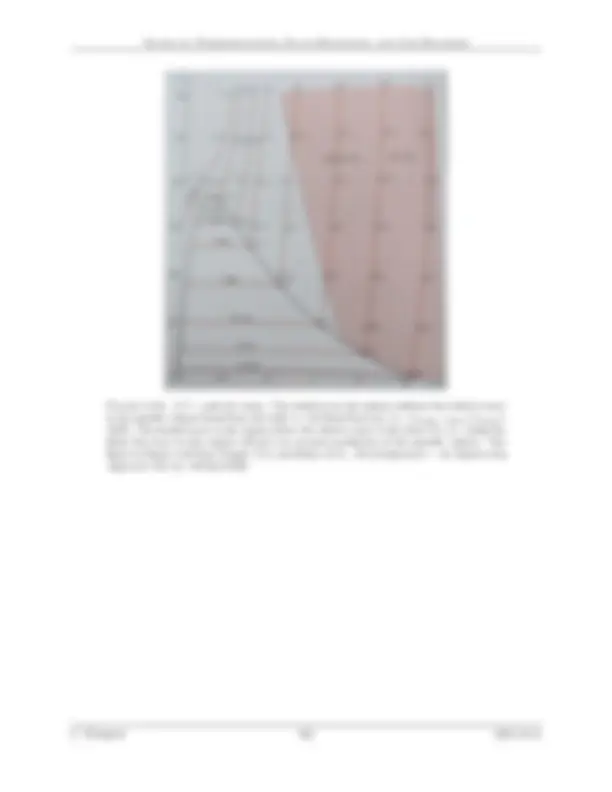
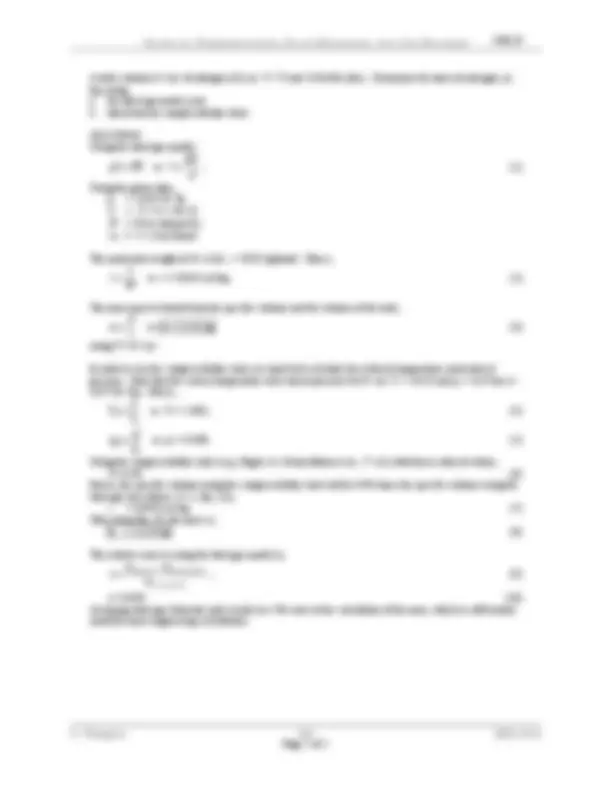
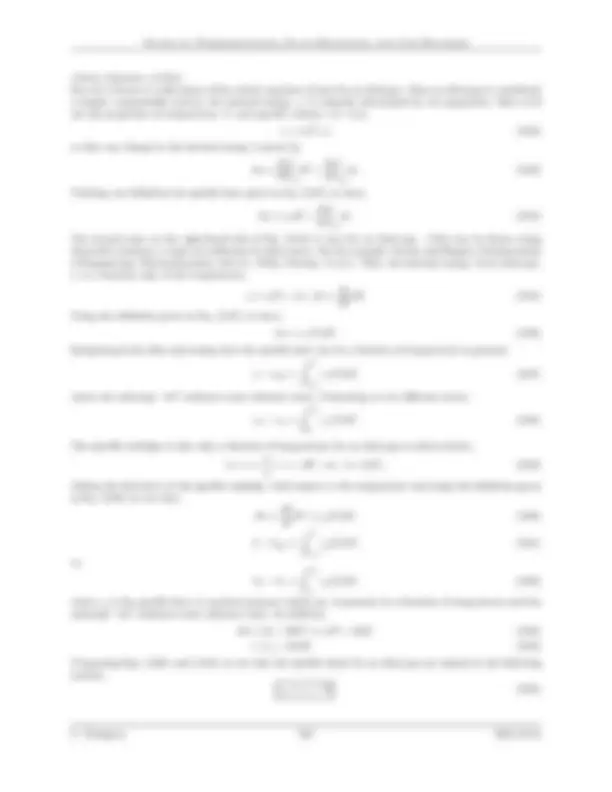
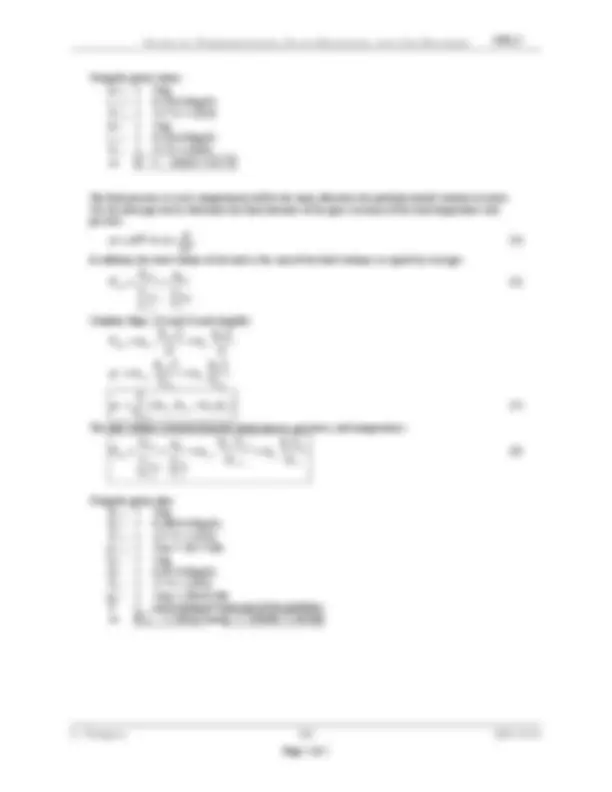
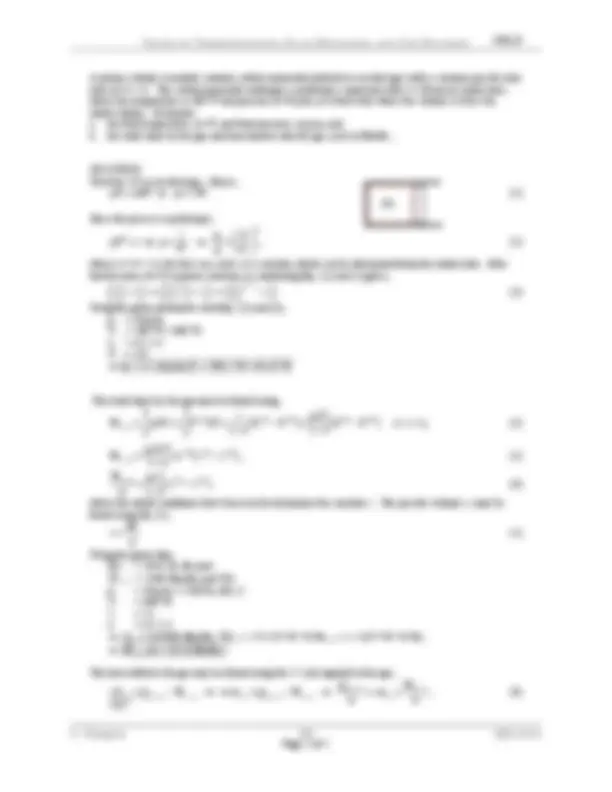
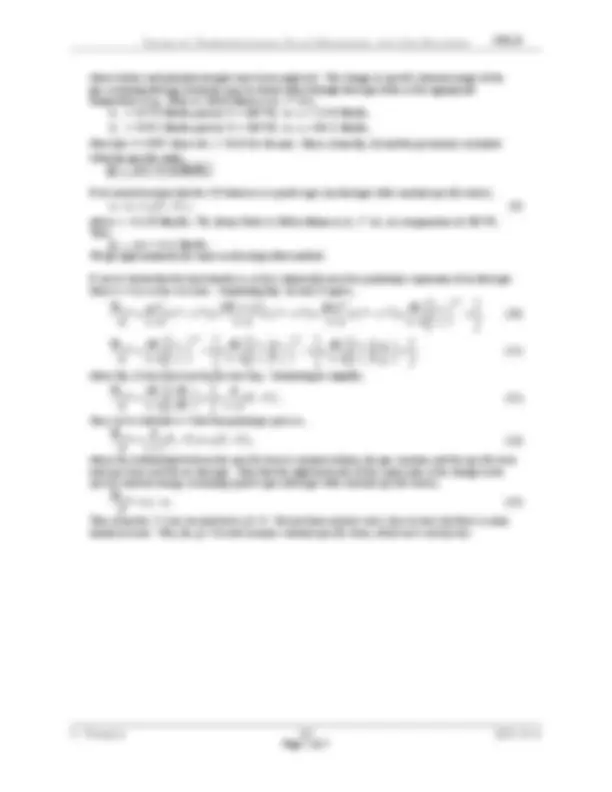


Study with the several resources on Docsity

Earn points by helping other students or get them with a premium plan


Prepare for your exams
Study with the several resources on Docsity

Earn points to download
Earn points by helping other students or get them with a premium plan
Community
Ask the community for help and clear up your study doubts
Discover the best universities in your country according to Docsity users
Free resources
Download our free guides on studying techniques, anxiety management strategies, and thesis advice from Docsity tutors
Equations of state cannot be obtained from thermodynamics but are obtained either from experimental measurements or from some molecular model.
Typology: Study notes
1 / 11

This page cannot be seen from the preview
Don't miss anything!







Notes on Thermodynamics, Fluid Mechanics, and Gas Dynamics
3.5.6. Ideal Gases
One particularly important class of substances that is the ideal gas. An ideal gas is a model describing the behavior of real gases in the limit of zero pressure and infinite temperature (i.e., zero density). It does not account for the interaction between molecules of the gas (e.g., inter-molecular forces). Nevertheless, the ideal gas model is a reasonably accurate model for gases where the system pressure is less than 0.05 times the critical pressure or the system temperature is more than twice the critical temperature (to be discussed).
3.5.6.1. Equation of State
An equation of state is a relationship between properties of a particular substance or class of substances. Equations of state cannot be obtained from thermodynamics but are obtained either from experimental measurements or from some molecular model. Note that there can be various types of equations of state, e.g., two equations of state for an ideal gas include a thermal equation of state which is the ideal gas law, p = ⇢RT , and a caloric equation of state which describes the relationship between the internal energy and temperature, du = c (^) v (T )dT.
Thermal Equation of State The thermal equation of state for an ideal gas is given by what is commonly referred to as the ideal gas law,
p = ⇢RT or pv = RT or p¯v = R¯ (^) U T or pV = mRT or pV = n R¯ (^) U T, (3.79)
where p is the absolute pressure of the gas, ⇢ is the gas density (= 1/v, i.e., the inverse of the specific volume), R is the gas constant for the gas of interest, and T is the absolute temperature. The quantity ¯v is the specific volume on a per mole basis, e.g., [¯v] = m^3 /mol, V is the volume, e.g., [V ] = m^3 , m is the mass, e.g., [m] = kg, and n is the amount of the substance, e.g., [n] = kmol. The quantity R¯ (^) U is the universal gas constant (discussed in the following notes).
Notes:
(1) Absolute pressures and temperatures must be used when using the ideal gas law or anything derived from the ideal gas law. (2) The gas constant, R, will be di↵erent for di↵erent gases. The gas constant can be determined in terms of the universal gas constant,
R =
where R¯ (^) U = 8314 J/(kmol · K) = 1545.4 (ft · lb (^) f )/(lb (^) mol · °R) = 1.986 Btu/(lb (^) mol · °R) and M W is the molecular weight of the gas. The gas constant for air is R (^) air = 287 J/(kg · K) or, in English units, R (^) air = 53.3 (ft · lb (^) f )/(lb (^) m · °R). Note that M W (^) air = 28.98 kg kmol �^1. (3) The compressibility factor, Z, is defined as,
Z :=
pv RT
p ⇢RT
If Z ⇡ 1 for a gas, then it can be modeled well with the ideal gas model. The compressibility factor, Z, is plotted in Figure 3.27 for a variety of substances as a function of the reduced pressure, p/p (^) c , and reduced temperature, T /T (^) c , where p (^) c and T (^) c are the critical pressure and temperature for the substance. Note that the critical temperature is the temperature above which a gas cannot be liquefied no matter how large a pressure is applied. The critical pressure is the minimum pressure for liquefying a gas at the critical temperature. (a) For values of p/p (^) c < 0 .05 or T /T (^) c > 2, Z ⇡ 1 so in this range the ideal gas model works well. (b) Table 3.1 lists the critical temperature and pressure values for various substances. (4) One should be careful in treating superheated water vapor, i.e., steam, as an ideal gas. Figure 3. shows a T - v plot for water. The points in the plot are the relative error between a specific volume found using the thermodynamic property table, which is very accurate, and the specific volume using the Ideal Gas Law, which is approximate ([|v (^) table � v (^) ideal |/v (^) table ] ⇤ 100%). The shaded area in
C. Wassgren 241 2021-12-
Notes on Thermodynamics, Fluid Mechanics, and Gas Dynamics
Figure 3.27. A plot of the compressibility factor Z as a function of the reduced pressure P (^) R = p/p (^) c for di↵erent reduced temperatures T (^) R = T /T (^) c.
Table 3.1. Critical temperatures and critical pressures for various gases.
Gas T (^) c [K] p (^) c [atm] air 132.41 37. He 5.19 2. H 2 33.24 12. N 2 126.2 33. O 2 154.78 50. CO 2 304.20 72. CO 132.91 34.
the plot is the region where the relative error is less than 1%, i.e., the region where steam can be reasonably modeled using the Ideal Gas Law. As a rule of thumb, it’s better to use the property tables for water in the superheated vapor region rather than assuming ideal gas behavior.
C. Wassgren 242 2021-12-
COE_
Page 1 of 1
A tank contains 0.5 m^3 of nitrogen (N 2 ) at - 71 °C and 1356 kPa (abs). Determine the mass of nitrogen, in kg, using, a. the ideal gas model, and b. data from the compressibility chart.
SOLUTION: Using the ideal gas model,
Þ , ( 1 )
Using the given data, p = 1356*10^3 Pa T = - 71 °C = 202 K = 8314 J/(kmol.K) Þ = 1.23 m^3 /kmol
The molecular weight of N 2 is MN 2 = 28.01 kg/kmol. Hence,
Þ v = 0.0442 m^3 /kg ( 2 )
The mass may be found from the specific volume and the volume of the tank,
Þ m = 11.31 kg ( 3 )
using V = 0.5 m^3.
In order to use the compressibility chart, we must first calculate the reduced temperature and reduced pressure. Note that the critical temperature and critical pressure for N 2 are Tc = 126 K and pc = 33.9 bar (= 33.9*10^5 Pa). Hence,
Þ TR = 1.603, ( 4 )
Þ pR = 0.400. ( 5 )
Using the compressibility chart (e.g., Figure A-1 from Moran et al., 7th^ ed.) with these reduced values, Z = 0.98. ( 6 ) Hence, the specific volume using the compressibility chart will be 0.98 times the specific volume using the ideal gas law (where Z = 1, Eq. ( 2 )), v = 0.0433 m^3 /kg. ( 7 ) Thus, from Eq. ( 3 ), the mass is, m = 11.54 kg ( 8 )
The relative error in using the ideal gas model is,
, ( 9 )
e = 0.020. ( 10 ) Assuming ideal gas behavior only results in a 2% error in the calculation of the mass, which is sufficiently small for most engineering calculations.
pv = RT v =
p
v
v =
v M
m =
v
Tc
pR =
p pc
ε =
m ideal gas − m compressibility m compressibility
Notes on Thermodynamics, Fluid Mechanics, and Gas Dynamics
C. Wassgren 244 2021-12-
Notes on Thermodynamics, Fluid Mechanics, and Gas Dynamics
Caloric Equation of State Now let’s return to a discussion of the caloric equation of state for an ideal gas. Since an ideal gas is considered a simple, compressible system, the internal energy, u, is uniquely determined by two properties. Here we’ll use the properties of temperature, T , and specific volume, v(= 1/⇢),
u = u(T, v), (3.82)
so that any change in the internal energy is given by,
du =
@u @T
v
dT +
@u @v
T
dv. (3.83)
Utilizing our definition for specific heat given in Eq. (3.67) we have,
du = c (^) v dT +
@u @v
T
dv. (3.84)
The second term on the right-hand side of Eq. (3.84) is zero for an ideal gas. (This can be shown using Maxwell’s relations, a topic not addressed in these notes. See for example, Moran and Shapiro, Fundamentals of Engineering Thermodynamics, 3rd ed., Wiley, Section 11.4.2.) Thus, the internal energy of an ideal gas, u, is a function only of the temperature,
u = u(T ) =) du = du dT
dT. (3.85)
Using the definition given in Eq. (3.67) we have,
du = c (^) v (T )dT. (3.86)
Integrating both sides and noting that the specific heat can be a function of temperature in general,
u � u (^) ref =
T (^) ref
c (^) v (T )dT, (3.87)
where the subscript “ref” indicates some reference state. Evaluating at two di↵erent states,
u 2 � u 1 =
T (^1)
c (^) v (T )dT. (3.88)
The specific enthalpy is also only a function of temperature for an ideal gas as shown below,
h = u +
p ⇢
= u + RT =) h = h(T ). (3.89)
Taking the derivative of the specific enthalpy with respect to the temperature and using the definition given in Eq. (3.68) we see that,
dh =
dh dt
dT = c (^) p (T )dT, (3.90)
h � h (^) ref =
T (^) ref
c (^) p (T )dT, (3.91)
or,
h 2 � h 1 =
T (^1)
c (^) p (T )dT, (3.92)
where c (^) p is the specific heat at constant pressure which can, in general, be a function of temperature and the subscript “ref” indicates some reference state. In addition,
dh = du + RdT = c (^) v dT + RdT, (3.93) = (c (^) v + R)dT. (3.94)
Comparing Eqs. (3.90) and (3.94) we see that the specific heats for an ideal gas are related in the following manner,
c (^) p = c (^) v + R. (3.95)
C. Wassgren 245 2021-12-
COE_
Page 1 of 2
One kilogram of air, initially at 5 bars (abs) and 77 °C, and 3 kg of carbon dioxide (CO 2 ), initially at 2 bars (abs) and 177 °C, are confined to opposite sides of a rigid, well-insulated container. The partition is free to move and allows conduction from one gas to the other without energy storage in the partition itself. Determine: a) the final equilibrium temperature b) and the final pressure You may assume that the specific heats for both the air and CO 2 remain constant over the range of temperatures: c v,air=0.726 kJ/(kg×K); c v,CO2=0.750 kJ/(kg×K); c p,air=1.013 kJ/(kg×K); c p,CO2=0.939 kJ/(kg×K)
Apply the 1st^ Law to the following CV.
where
(well-insulated tank)
(rigid tank)
Assuming constant specific heats (perfect gases) and simplifying COE gives:
Since the partition is conductive, resulting in:
CV into on CV CV
into CV
on CV
T CO , (^) 2 f = T air, (^) f = Tf
2 2 2 2 2
CO ,CO CO , air ,air air, CO ,CO air ,air
v i v i f v v
m c T m c T T m c m c
air 1 kg initially at 5 bars 77 °C
3 kg initially at 2 bars 177 °C
movable, conductive partition
well-insulated, rigid tank
air 1 kg initially at 5 bars 77 °C
3 kg initially at 2 bars 177 °C
movable, conductive partition
well-insulated, rigid tank
Notes on Thermodynamics, Fluid Mechanics, and Gas Dynamics
C. Wassgren 247 2021-12-
COE_
Page 2 of 2
Using the given values: m CO2 = 3 kg cv, CO2 = 0.750 kJ/(kg×K) T CO2, i = 177 °C = 450 K m air = 1 kg cv, air = 0.7 26 kJ/(kg×K) T air, i = 77 °C = 3 50 K Þ Tf = 426 K = 153 °C
The final pressure in each compartment will be the same otherwise the partition would continue to move. Use the ideal gas law to determine the final densities of the gases in terms of the final temperature and pressure.
( 3 )
In addition, the total volume of the tank is the sum of the final volumes occupied by each gas.
( 4 )
Combine Eqns. ( 3 ) and ( 4 ) and simplify.
The tank volume is known from the initial masses, pressures, and temperatures.
( 6 )
Using the given data: m CO2 = 3 kg R CO2 = 0.1889 kJ/(kg×K) T CO2, i = 177 °C = 450 K p CO2, i = 2 bar = 202.7 kPa m air = 1 kg R air = 0.287 kJ/(kg×K) T air, i = 77 °C = 350 K p air, i = 5 bar = 506.63 kPa Tf = 426 K (from previous part of the problem) Þ V tank = 1.46 m^3 and pf = 250 kPa = 2.46 bar
p p RT RT
V tank =
m CO 2 ρCO 2 ,^ f = V CO 2 , f
m air ρair, f = V air , f
2 2
CO air tank CO air
f f f f
V m m p p
2 2
CO air CO air tank tank
f f f
p m m V V
tank
f f
p m R m R V
V tank =
m CO 2 ρCO 2 , i = V CO 2 , i
m air ρair, i = V air , i
= m CO 2
R CO 2 T CO 2 , i p CO 2 , i
R air T air, i p air, i
Notes on Thermodynamics, Fluid Mechanics, and Gas Dynamics
C. Wassgren 248 2021-12-
COE_
Page 2 of 2
where kinetic and potential energies have been neglected. The change in specific internal energy of the gas, assuming ideal gas behavior, may be found either through ideal gas tables at the appropriate temperatures (e.g., Table A-23E of Moran et al., 7th^ ed.), = 3275.8 Btu/lbmmol (at T 1 = 660 °R) Þ u 1 = 117.0 Btu/lbm = 2479.2 Btu/lbmmol (at T 2 = 500 °R) Þ u 2 = 88.51 Btu/lbm Note that where M CO = 28.01 lbm/lbmmol. Hence, from Eq. ( 8 ) and the previously calculated value for specific work, Q into gas/ m = - 0.16 Btu/lbm.
If we instead assume that the CO behaves as a perfect gas (an ideal gas with constant specific heats), , ( 9 ) where cv = 0.178 Btu/(lbm.°R) (from Table A-20E in Moran et al., 7th^ ed., at a temperature of 100 °F). Thus, Q into gas/ m = - 0.11 Btu/lbm. We get approximately the same result using either method.
It can be shown that the heat transfer is, in fact, identically zero for a polytropic expansion of an ideal gas when n = k , as is the case here. Combining Eqs. ( 6 ) and ( 7 ) gives,
, ( 10 )
where Eq. ( 2 ) has been used in the last step. Continuing to simplify,
. ( 12 )
Since we’re told that n = k for this polytropic process,
, ( 13 )
where the relationship between the specific heat at constant volume, the gas constant, and the specific heat ratio has been used for an ideal gas. Note that the right hand side of this expression is the change in the specific internal energy, assuming a perfect gas (ideal gas with constant specific heats),
. ( 14 )
Thus, from the 1st^ Law, we must have Q = 0. Our previous answers were close to zero, but there is some numerical error. Plus, the Q = 0 result assumes constant specific heats, which isn’t exactly true.
u 1 u 2 u = u M
W by gas m
p 1 v 1^ n 1 − n
1 − n
RT 1 v 1^ n −^1 1 − n
1 − n
v 2 v 1
1 − n − 1
W by gas m
1 − n
v 2 v 1
1 − n − 1
1 − n
v 2 v 1
v 2 v 1
− n − 1
1 − n
v 2 v 1
p 2 p 1
W by gas m
1 − n
1 − n
W by gas m
1 − k
W by gas m
= u 2 − u 1
Notes on Thermodynamics, Fluid Mechanics, and Gas Dynamics
C. Wassgren 250 2021-12-
Notes on Thermodynamics, Fluid Mechanics, and Gas Dynamics
(a)
(b)
Figure 3.29. Plots of (A) ¯c (^) p / R¯ (^) U as a function of temperature for various gases. (Figure from ???.) (B) c (^) p as a function of temperature for air at various pressures. (Figure from The Engineering ToolBox.)
3.6. The Second Law of Thermodynamics
The First Law must be satisfied for a process to occur, but it doesn’t indicate if the process will occur. For example, consider a system consisting of a block sliding down an inclined surface under the action of gravity. The block is initially at rest and is at rest at the final state so the change in kinetic energy is zero. Assume
C. Wassgren 251 2021-12-
Not part of this reading.